|
Join the Alaska & Yukon Railroad & Self Drive Tour from Juneau to Anchorage. It's all about magnificent scenery, wildlife, adventure and history on our unique one way tour from Juneau to Anchorage. Explore Glacier Bay National Park - a UNESCO protected glaciated wonderland, cruise the world-renowned Inside Passage, follow the trail of 1899's when the magic and mystery of the gold rush comes alive again in Dawson City. Enjoy the drive along the Top of the World Highway, join us for scenic cruise to Glacier Bay and the comfortable train ride aboard the famous Alaska Railroad to Denali National Park where outstanding grizzly bear viewing awaits you. The very Best of Alaska and the Yukon Territory ! |
RRSD#02 Into the Wild - Rail & Road Tour from Juneau to Anchorage
Tour Itinerary
Dates | Rates
Options | Extensions
Accommodation
Rental Car
Railroad FAQ
|
Day
01 |
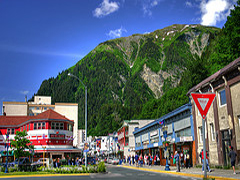 |
Juneau Arrive in Juneau. Transfer to your hotel in Juneau. Originally a fishing outpost for local Tlingit Native Americans, the area now known as Juneau was founded in 1880 after two prospectors, Richard Harris and Joseph Juneau, discovered gold. Juneau became the capital of Alaska in 1906. This afternoon join a city sightseeing tour (included) of Juneau including the visit to Mendenhall Glacier - a half-mile wide and 1,800-feet deep ice field - which is for many the most accessible and breathtaking glacier in Alaska. The Mount Roberts Tramway takes guests up to an observation deck that is about 2,000 ft. above Juneau, providing arguably the best picture-taking opportunities in the state (optional). Explore the natural and cultural roots of Juneau and check out the Alaska State Museum, which recounts not only the native people of Alaska and its early settlers, but also the natural wildlife that can be seen throughout the region. Overnight: Juneau |
|
Day
02 |
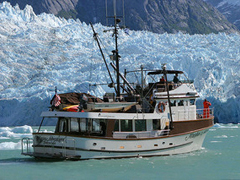 |
Juneau | Optional: Glacier Bay Tour or Tracy Arm Fjords Cruise Option I: Juneau Tracy Arm Fjords Cruise Option II: Glacier Bay National Park day tour. Early morning flight to Gustavus, board the high-speed catamaran and discover Glacier Bay's West Arm. For 7-hours passengers will explore a diversified landscape with a rich flora, fauna and history. Explore a waterway that was under a river of ice only 250 years ago. A park ranger assists onboard to spot wildlife and provide information. Glacier Bay includes numerous tidewater glaciers - several are actively calving icebergs into the bay. As water undermines the ice fronts, great blocks of ice - up to 200 feet high - are crashing into the water. The Johns Hopkins Glacier calves such enormous volumes of ice and it is unsafe to get within a 2-mile radius of its cliffs. Watch out for humpback whales, orcas, puffins and murres at the Marble Islands, mountain goats high on the cliffs, and harbor seals on the icebergs. Return to Juneau. Option: Overnight at Glacier Bay Lodge and fly directly to Haines. |
|
Day
03 |
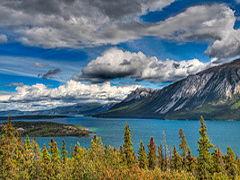 |
Juneau - Haines (Ferry Transfer, Start Driving Tour) Board the Alaska Ferry / catamaran for a relaxed cruise through the most scenic stretch of Alaska's Inside Passage to Haines. Pick up your rental car and check into your hotel. Haines is situated at the upper end of the Inside Passage, surrounded by snowcapped mountains, lush meadows and forests. Across the waters of the Chilkat River is Pyramid Harbor and the start of the Dalton Trail — one of the routes to the gold fields of the Klondike. The Chilkat Bald Eagle Preserve can be found below Klukwan on the Chilkat River flats (mile 18 to 24 on the Haines Highway). This area is called the "Council Grounds" because of its large congregation of eagles. The Chilkat Bald Eagle Preserve was established to protect the world's largest concentration of Bald Eagles and their critical habitat. Visit the Fort William H. Seward with its old officers' headquarters and barracks buildings, designated as a National Historic Site. Overnight: Haines |
|
Day
045 |
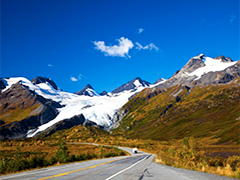 |
Haines - Whitehorse The Haines Highway winds from Haines over the Chilkat Pass - the highest summit on this highway. You pass Klukshu, a native summer fishing camp offering great photo opportunities. You'll pass Kluane National Park, covering the largest non-polar icefields in the world. Visit the sheep mountain visitor center with its interpretive programs about the flora and fauna. Viewing telescopes are available where you can spot dall sheep on the mountain slopes. Continue to Whitehorse and discover the many attractions of Yukon's capital: The SS Klondike Historic Park – with an historic 210 ' long sternwheeler, the Yukon Archives with documented history back to 1845, the McBride Museum showcases the Yukon's cultural and natural history - and the Log Church Museum displays relics of northern pioneer missions. Experience gold rush history first hand on a riverboat tour on the Yukon River to Miles Canyon ! Driving Distance 250 miles | Overnight: Whitehorse |
|
Day
05 |
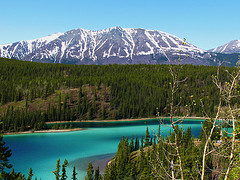 |
Whitehorse - Dawson City Visit the large Yukon Beringia Center: During the last ice age, a land bridge joined Asia to Alaska and the Yukon, forming a subcontinent known as Beringia. Bordered on all sides by glaciers, Beringia was once home to woolly mammoths and other fascinating Pleistocene-era animals, as well as to cave-dwelling humans. This museum presents the archaeological and paleontological past of Beringia, with life-size exhibits of ice-age animals, multimedia displays, films, and dioramas on its prehistoric people, animals, plants, and ecosystems. Try your hand at hurling an atlatl, which is a sling and spear weapon that early hunters used in these parts 10,000 years ago. After a side trip to the scenic Miles Canyon leave Whitehorse and drive north on the famous Klondike Highway through stands of white birch and black spruce, often paralleled by the mighty Yukon River. Stop at the Five Finger Rapids and hike down to the shore of the Yukon River. Distance: 340 Miles | Overnight: Dawson City |
|
Day
06 |
 |
Dawson City Dawson City had once a population of 35,000, but the "stampede" of `98 died out almost as quickly as it began. Visit the historical buildings, Jack London and Robert Service cabins, abandoned commercial buildings and old stores that were the pulse of the gold rush capital in its hey-days. And as you drive through the heart of Dawson City, your imagination will run to the likes of Klondike Kate, Arizona Charlie Meadows and Diamond Tooth Gertie strolling down Dawson's boardwalks. Their spirit is as alive today as it was in 1898. From the one-time capital of the Yukon you'll follow history up Bonanza Creek (pan for gold) to Discovery Claim and Grand Forks once boasted a population of 10,000 where the Eldorado Creek and Upper Bonanza come together to form the "mighty" Bonanza Creek. Overnight: Dawson City |
|
Day
07 |
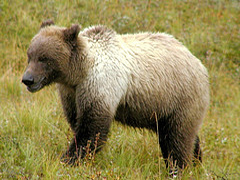 |
Dawson City - Fairbanks A drive on "Top of the World Highway." Please allow plenty of time for travel as the road is winding and narrow in many places. The highway #9 continues from Dawson to the Alaska and Yukon border, where it becomes the Taylor Highway - Alaska Route #5. Much of its route meanders along the tops of mountains and ridges with endless views. Those driving along this route are able to enjoy beautiful vistas including spectacular alpine valleys. During the summer months the sun sets forever and you'll have hours of light to set-up that special sunset photograph. It all began 1894 with Robert Henderson, a fur trapper and part-time prospector who found gold in Rabbit Creek (later renamed Bonanza) not far from where the Klondike River empties into the Yukon. By 1904, an estimated $100 million in gold had been shipped from the Klondike. Distance 340 Miles | Overnight: Fairbanks |
|
Day
08 |
 |
Fairbanks (End Driving Tour) In 1902, Felix Pedro found gold in the region and thousands of prospectors swarmed to the area. Nearly a century later, Fairbanks is the trade center for the Interior and Far North Alaska. Today you have the unique chance to join an arctic flight to Alaska's vast, roadless interior. Enjoy the scenic flight above the arctic circle and experience how the Gwich'in Athabascan Natives live in "Bush" Alaska. Visit the renowned Alaska University Museum featuring Alaska's best natural history collection or take an authentic sternwheeler cruise for a scenic 20-mile roundtrip on the Chena and Tanana Rivers. Other sightseeing options are a drive along the Chena Hot Springs Road (watch out for moose!), take a hiking trip and visit Chena. Relax in the large natural outdoor rock lake. Step inside the Aurora Ice Museum and grant yourself to an "Appletini" beverage served in an ice glass. Return your rental car in the evening and get ready for the exiting rail tour. Overnight: Fairbanks |
|
Day
09 |
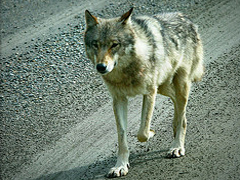 |
Fairbanks - Denali National Park | Rail Tour Railroad departure in Fairbanks at 8:15 AM. Choose between standard and glass-domed train compartments with large panorama windows and unobstructed views of snowcapped mountains, pristine scenery and wildlife. Enjoy the scenic rail tour south via Nenana - known for its Alaska Ice Classics - and further on to Denali. Arrive at the Denali Park Rail Station at 12:30 PM and transfer to your hotel. In the afternoon join the Tundra Wilderness Tour, 54 mile journey into Denali National Park to the Toklat River rest area. The 7-hour guided tour offers incredible scenery of the Alaska Range and Mt. Denali, narrated history of the park and the best opportunity to view the park's diverse wildlife. On days when Denali (formerly Mt. McKinley) is visible, it may be possible to travel to Stony Hill Overlook at mile 62 where the mountain first becomes fully visible from base to summit - an impressive view. Return to your hotel around 8:00 PM. | Overnight: Denali Park |
|
Day
10 |
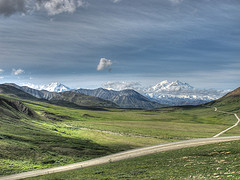 |
Denali National Park - Talkeetna | Rail Tour Morning at leisure: attend a ranger sled dog demonstration, join a Jeep Safari or raft down the Nenana River. Enjoy a scenic float trip near the entrance of Denali with a taste of whitewater rafting. This guided trip skirts the boundaries of Denali National Park down the glacier-fed Nenana River. Experience beautiful scenery and keep your eyes out for wildlife as you raft downstream 11 miles. The most scenic portion of the Nenana River gives you a thrilling, yet safe rafting. More adventurous guests have the option to continue with the Canyon Run! Get into real whitewater rafting as you hang on through thrilling rapids. Board the Alaska Railroad at noon and relax in your comfortable reclining seats, enjoy a delicious lunch onboard or listen to the local tour guide giving commentaries. Have your camera ready as the train crosses Hurricane Gulch Bridge, 300 feet above the creek. Transfer to a Talkeetna downtown hotel or to a beautiful deluxe mountain lodge with breathtaking views of Mt. Denali. |
|
Day
11 |
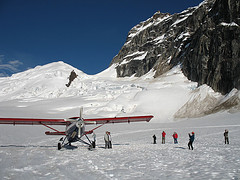 |
Talkeetna - Anchorage | Rail Tour This morning you have the option to join us for a flightseeing trip within a 6-Miles range of Mt. Denali's 20.320 ft summit. Get close up views of the Kahiltna and Ruth Glacier with its 9.000 ft Great Gorge and magnificent ice-falls. See the Sheldon Amphitheatre and add on a glacier landing at the base of Mt. Denali. Experience the excitement of standing among the great peaks - the immense scale will astound you. Talkeetna is nestled at the base of North America's tallest peak and provides outstanding panoramic views of the Alaska Range that can be enjoyed and photographed from several places as you wander through the historic town and discover it's unique location. Your rail tour continuous via Wasilla - home of the Alaska Iditarod Sled Dog Race - to Anchorage. Transfer from the rail station to your hotel. Try some fresh Alaska seafood for your dinner and enjoy a evening stroll along the Tony Knowles Coastal Trail with sweeping views over the inlet. | Overnight: Anchorage |
|
Day
12 |
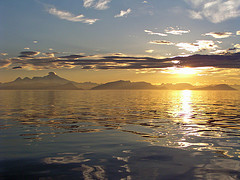 |
Anchorage Your tour ends today with the transfer to the airport. Spend the day in Anchorage if you booked an evening flight. Anchorage features dozens of parks and 122 miles of paved bike paths. Warmed by a maritime climate, you can spend the day salmon fishing at Ship Creek, hiking the nearby mountains, photographing glaciers and dining at a four-star restaurant. Within a 15-minute drive from downtown on the hillside is the tree-lined trailhead of Anchorage’s most popular hike, Flattop Mountain. A short floatplane ride opens up the possibility of almost any type adventure. That’s one reason why Lake Hood is the world’s busiest floatplane base. Tour extension on request. |
| Rates in US $ / per Person | Single | Double | Triple | Quad | Child | |
| May 10 - May 31 | $5253.00 | $3161.00 | $2559.00 | $2262.00 | $715.00 | |
|
|
||||||
| June 1 - August 31 | $5761.00 | $3403.00 | $2721.00 | $2383.00 | $759.00 | |
|
|
||||||
| September 1 - September 20 | $5253.00 | $3161.00 | $2559.00 | $2262.00 | $715.00 | |
| Rates in US $ / per Person | Single | Double | Triple | Quad | Child | |
| May 10 - May 31 | $6339.00 | $3904.00 | $3180.00 | $2822.00 | $965.00 | |
|
|
||||||
| June 1 - August 31 | $7057.00 | $4264.00 | $3427.00 | $3005.00 | $978.00 | |
|
|
||||||
| September 1 - September 20 | $6339.00 | $3904.00 | $3180.00 | $2822.00 | $965.00 | |
| Daily Departures from May 10 - September 20 |
|
| Rates in US $ | per Person | Adult |
| Juneau: Full Day Glacier Bay Tour (incl. return flight, glacier bay cruise) | |
| Juneau: Whale Watching Cruise & Mendenhall Glacier | |
| Fairbanks: Evening Bush Mail Plane Flight to an Arctic Village | |
| Fairbanks: 5 hr Arctic Circle Flightseeing Tour to Fort Yukon & the Yukon River | |
| Talkeetna: Mt. Denali Flightseeing Tour + Optional Glacier Landing | |
|
Superior Hotel Category (*** Hotels, Motels & Lodges) Superior Hotels offer a good amount of essential guest services and are located in downtown locations and/or in/near national park areas. All superior class hotel rooms are equipped with a private bathroom. Example larger hotel chains for superior class hotels are: Holiday Inn, Howard Johnson, Guesthouse Inn, Ramada Inn, High Country Inn, Aspen Hotel Group, Comfort Inn. As you might be aware, that these hotel chains are not available throughout Alaska. In such cases or/and when we feel that Alaskan owned hotels & lodges offer a better experience, we go with that choice. Cabins and Cottages also considered in this category to make your experience even more ‘Alaskan’. We ensure that all the Cabins & Cottages have a private bath to make your stay comfortable. 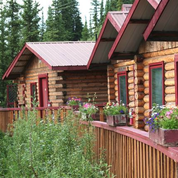 First Class Hotel Category (**** Hotels & Lodges) First Class hotels usually offer an additional amenities such as a restaurant, lounge, bar, fireplace seating, fitness room, swimming pool/hot tub, etc. All rooms in First Class hotels belong to a higher category and are always equipped with a private bathroom. Most hotels in this category are usually located in prime locations in prime downtown locations or in national parks. These include larger hotel chains such as: Marriott Hotels, Sheraton, Westmark Hotels, Princess Hotels and Lodges, Clarion Suites, Comfort Inn & Suite. The larger hotel chains are only available in Anchorage and Fairbanks. If a major hotel chain is not available, we prefer to book local premium hotels/deluxe cabins or cottages for our clients. Please note that premium accommodations may not be available in small towns; in such cases we will book the best available accommodation. 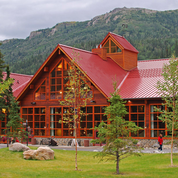 |
Rental CarWe’ve put together a selection of rental car categories designed specifically with Alaska travel in mind. Whether you’re planning a short getaway or a longer adventure, traveling solo or with a group, or working within a specific budget, you’ll find options that balance comfort, space, and practicality for the unique conditions of Alaska’s roads. From midsize cars for easy city driving to spacious SUVs and vans ideal for longer scenic routes or family trips, there’s a category for every type of journey. Not sure which vehicle is right for your plans? Simply reach out to us—we’ll be happy to recommend the rental car category that best matches your itinerary, group size, and travel style. Here are the car rental categories we offer: Mid Size Car (included - part of the package / additional day $150) Generally, midsize cars measure between 180 to 195 inches in length but can vary depending on specific models. Mid-size cars, also commonly known as intermediate or standard cars, are four-door sedans that are more spacious than compact cars while still being fuel-efficient. They can fit 3 or sometimes 4 bags depending on the model. They feature more interior space compared to compact cars and offer comfortable seating for four to five passengers.  Full Size Car (upgrade $12 per day / additional day $160) Full Size cars are what many people would describe as large cars. A full-size car typically refers to a vehicle that offers more extensive interior space, comfort, and power compared to smaller vehicles such as compact or midsize cars. These cars usually have larger dimensions, including length, width, and height. They commonly feature roomy interiors with ample seating for five or more passengers along with expanded trunk capacity for luggage or cargo. Historically, full-size cars were synonymous with large sedans boasting V8 engines and body-on-frame construction. While this has changed over time due to evolving industry trends and technological advancements, what remains consistent is the emphasis on spaciousness, comfort, and performance these vehicles provide.  Standard Size SUV (upgrade $88 per day / additional day $240) SUVs (short for sport or suburban utility vehicles) are good-sized vehicles with a rugged look, set higher off the road than normal cars. In an SUV, the description of “standard” generally refers to the size of the SUV. The standard SUV is larger than the intermediate or compact versions. These full-size models are more powerful, like a truck, and they are usually more equipped to handle a wider variety of terrains and road conditions as well. In addition to being powerful, their size also means that they typically have more seating capacity than the smaller SUVs. They can seat more passengers and have more cargo space for transporting luggage and equipment.  Standard Elite SUV (upgrade $105 per day / additional day $255) Perfect for families, groups, and adventurous travelers, the Standard Elite SUV delivers a spacious and comfortable ride with room for up to 7 passengers. These versatile SUVs combine strong performance with practical features, including automatic transmission and air conditioning, making them ideal for both city streets and Alaska’s rugged landscapes. Models in this category offer generous cargo space for luggage, gear, or supplies, ensuring every trip is smooth and stress-free. With their reliable handling, powerful engines, and family-friendly interiors, Standard Elite SUVs are built for travelers who want comfort, convenience, and confidence on the road. Book from this vehicle group to enjoy a safe, capable, and spacious SUV designed to make every journey a memorable adventure. 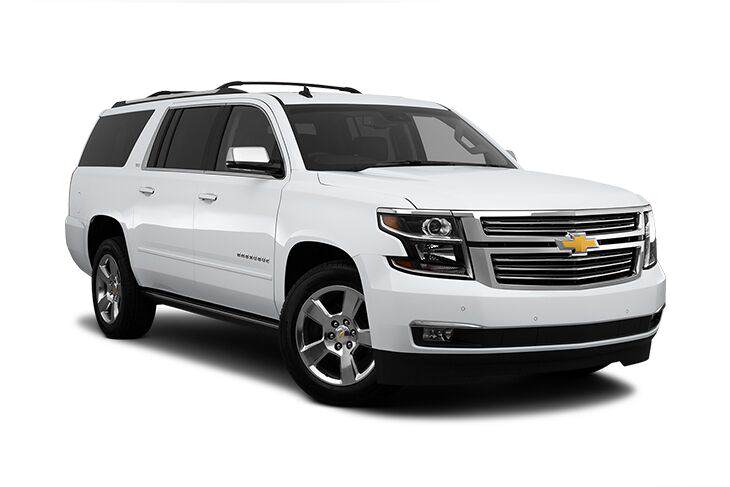 Mini Van (upgrade $125 per day / additional day $275) This roomy mini van is your ticket to family adventures and travel memories on your next rental. More spacious than a full-size car, and with better gas mileage than an SUV, a minivan is a 7-passenger van that provides unbeatable comfort and convenience. By providing leg and luggage room, configurable seating and storage layouts, easy in-and-out, competitive fuel efficiency, and high-performance drive—all without sacrificing style—minivans accommodate every kind of group outing, from lengthy family vacations to quick business trips. Did somebody say “road trip”?  11 Passenger Van (upgrade $250 per day / additional day $400) Choose a 11-person passenger van so that no one gets left behind on your road trip or vacation. Instead of trying to coordinate a car pool; save time, resources, and gas money by putting everyone together in one clean and comfortable van. You'll find each passenger has much more leg room. Sample Models: Chevrolet Express, Ford Transit or similar Sample Features: 3 Doors –10 to 11 Passengers- 6 Large Suitcases - Air-conditioning - Automatic Transmission 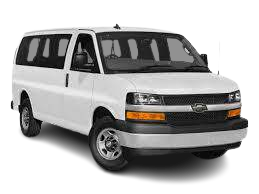 |
 |
| Alaska Rail Tour Services Regular Seating and Private Dome Car Choices Our Alaska Rail Tours are available with the following classes of service: Denali Star, Adventure Class Service | Many people prefer the standard class for its single level stability, generous seating and the ability to easily walk between different cars on the train. Gold Star Dome Cars Are the newest first-class rail cars in Alaska with large picture windows and fine dining options. Upper level dome car 360-degree viewing seating, priority check in, outdoor viewing deck. The lower level provides a restaurant, bar and gift shop. Midnight Sun Express Dome Cars | These 2-story dome cars with large multiple outside viewing platforms are operated by a private company. Enjoy the full-time 360-degree view dome seating with plenty of leg – and storage room. Additional features are: GPS assisted monitors, restaurant, bar and gift shop. The 1950’s Vintage Cars | The 1950's-era vintage railcars built by the well known Budd Company were some of the last reminders of the Golden Age of rail. A private company began acquiring Budd dome cars for passenger service on the McKinley Explorer train in Alaska. The seven cars the: Matanuska 508, Chena 509, Chulitna 510, Tanana 512, Talkeetna 513, Kashwitna 553 and Eklutna 554 were purchased and completely refurbished. These railcars were to become the most historic and elegant way to travel through America's Last Frontier. Mc.Kinley Explorer Dome Cars | Are the largest domed cars ever build with plenty of legroom, wide isles and additional luggage storage space. The seats are on the upper level – with restaurant, gift shop and bar downstairs - providing a 360-degree view through the glass windows around and the glass dome above you. All seats are wired so you may listen to music and recorded narration. GPS assisted monitors in each car are tracking the exact location. The covered outside viewing platform is a great feature for a breath of fresh air. All Alaska Rail Tours are including a pre-confirmed and assigned seat as well as on-board narration services. |
| Children Rate We provide a reduced tour rate for children up to 11 years. Please refer to each individual tour for more information. Children will be accommodated in parents room. |
| Dining The Midnight Sun Express, the McKinley Explorer and the Alaska Railroad Gold Star Dome Cars are offering full service breakfast, lunch and dinner options (all custom made to order) at the on-board restaurants. You will have the opportunity to visit the dining room and order freshly prepared food from the menu. Since all of our dishes are prepared to order we will do our best to accommodate all dietary concerns. Please notify us of any special dietary requirements at the time of reservation. Alcoholic beverages are also available. |
| Gratuities Recommended gratuities to the on-board train staff and host guides are $3.00 to $5.00 per person and day. Gratuities for meal and bar service are entirely discretionary, but 15% is customary in most Alaskan restaurants. All tipping is a matter of your individual preference and is of course - always voluntary. |
| Hotel Accommodation For additional information and addresses on hotels, lodges and resorts included in your railroad tour package, please check our „Info Center“ area. |
| Luggage Transfer & Access Passengers are limited to two pieces of checked baggage, not to exceed 50 pounds, that must be checked with the Alaska Railroad without charge. Each passenger may also take one carry on, not to exceed 2 ” by 14” by 17 ”, which will stored under your seat on the viewing level. Please pack any medications, cameras, binoculars or valuables in your carry-on. |
| Pets Are not allowed onboard (except assistance dogs) |
| Smoking Is not permitted on-board the trains. Smoking is allowed outside on the platforms. Ashtrays are available on the outside viewing platform. |
| Sightseeing Tours Most of our tours are including scheduled sightseeing trips. For more information please refer to each individual tour package. In addition to these scheduled tours we also provide a variety of exciting optional sightseeing trips with a great value. Please Note: Optional sightseeing tours are only available in connection with a confirmed rail tour package reservation. |
| Tickets & Travel Documents You’ll receive your boarding passes, travel documents and additional tour information on the departure day at the rail station. Ticketless travel options are available upon request. |
| Transfers Most scheduled transfers indicated within the itinerary are included in our rail tour packages. Optional pre/post hotel tour accommodation are including transfers from/to the airport. Private limousine and/or group coach transfers are available for an additional charge. |
| Wheelchair Access Each train has at least one rail car that this fully accessible to wheelchairs. A specially designed lift makes getting on and off the train easy and safe. There are also accessible restrooms on each of the accessible rail cars. |
| Alaska Rail Tour Travel Destinations Anchorage to Talkeetna | Anchorage is headquarters to the Alaska Railroad and the journey to Fairbanks begins here. Several miles into the trip, the heavy birch forests of Eagle River and Chugiak lead to the Knik and Matanuska Rivers.The expansive watershed harbors wildlife like moose, bear, the occasional wolf and abundant waterfowl. About 40 miles from Anchorage comes the Matanuska Valley, Alaska's agricultural center and home to the towns of Palmer and Wasilla. Just south of Talkeetna, 70 miles further, the first view emerges of Mt. Denali, North America's highest peak. The train takes its first stop in Talkeetna, a small town with a mining history and now, a popular takeoff point for climbers to Mt. Denali. Talkeetna to Denali | From Talkeetna, the track follows the serpentine banks of the Susitna River. On clear days, more views of Mt. Denali emerge across the river presenting many chances for photos. Black and brown bear frequent the sandbars and scuttle into the brush as the train approaches. Next, the Indian River Canyon is home to many beavers and beaver lodges can be seen in the ponds along the way. The track climbs toward tree line, first crossing Hurricane Gulch, the longest bridge on the railroad just over 914 feet and 296 feet above Hurricane Creek. The train moves into Broad Pass, at 2,363 feet it's the highest point on the railroad, and where caribou migrate through during the fall. Thousands of travelers visit Denali National Park and Preserve to see wildlife like wolves, caribou, Dall sheep, moose and bear, and, of course, Mt. Denali. Denali to Fairbanks | The coal-mining town of Healy follows after a 10-mile jaunt through Healy canyon, where the surging waters of the Nenana River cuts through the steep-sided cliffs. As the track levels out, Nenana comes into view. It is home to one of the remaining original Alaska Railroad Depots, now a museum and gift shop. The track cuts through the northern boreal forests of interior Alaska. Birch, aspen and willow fill this landscape where gold miners first came to seek their fortunes. Fifty-eight miles from Nenana, Fairbanks, the "Golden Heart City" signals the end of the line - but just the beginning for more adventure, culture and history in the Last Frontier. Seward to Anchorage | Your journey starts in Seward, the southern terminus of the railroad. It quickly begins its climb through primeval forests of Sitka spruce. After crossing Snowy River, Kenai Lake comes into view, set off with its stunning aqua color and surrounded by soaring mountains. Moose Pass - Thirty miles into the trip, the track winds through Moose Pass, a former railroad construction camp on the shores of Trail Lake. As the rail ascends into the Kenai Mountains, it leaves behind the forests and reveals mountain meadows and streams of gin-clear glacial waters. Trail Glacier appears on the right and soon after, the summit of Grandview at 1,063 feet and the historic Loop District - named for a complex series of trestles built to handle the steep grade in the age of steam engines. In the same stretch, Bartlett Glacier crowds the track just 800 feet away. Placer River Valley - After passing through a series of short tunnels, the track descends to the Placer River Valley near Spencer Glacier. Moose, bear and wolves populate the valley among the willow and alder trees. Trumpeter swans migrate through in spring and fall and arctic terns hover above the ponds and river looking for small fish and insects. Twelve miles later Turnagain Arm appears, where 40-foot tides rush into the narrow confines of the Chugach Mountains. Beluga whales pursue salmon and other schooling fish. Next comes Girdwood, home to Alaska's premier ski resort, a 40-mile commute from Anchorage. Chugach National Forest - The Chugach National Forest borders Turnagain Arm, some six million acres, the second largest in the U.S. Bald eagles cruise the thermals above and Dall Sheep come to feed on the low plants growing on the cliffs bordering the track. Next comes Potter Marsh in the Anchorage Coastal Wildlife Refuge. Anchorage is the final stop, 114 miles out of Seward. |
